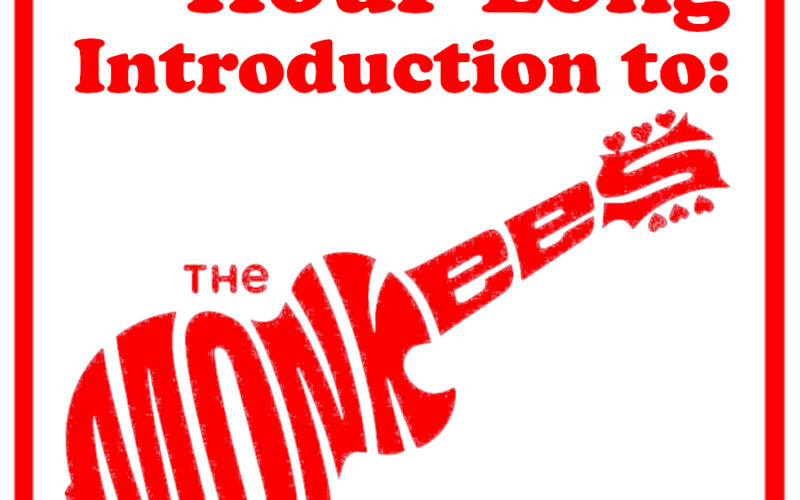A Chronological Introduction to The Monkees: HOUR FOUR
While one would have expected The Monkees to fade into obscurity after the decade ended like so many other sixties fads, for some reason they kept coming back. Like the swallows of San Juan Capistrano. Or a herpes outbreak.
In 1976, on the 10th anniversary of the show’s debut, Micky and Davy were looking to get the band back together. They were unable to talk either mike or Peter into it, so instead they reunited with Monkees songwriters Tommy Boyce and Bobby Hart. For legal reason they couldn’t call themselves The Monkees, but the self-titled album they recorded is essentially a Monkees record in everything but name. There’s some good songs on there – as well some that either Tommy or Bobby sang that lacked the personality of a good Monkees tune. The first three songs on this playlist come from that album. I also included Gotta Get Up from the cast recording of a 1977 West End revival of Harry Nilsson’s The Point, as that also feels like something of a Monkees reunion with the two main singers doing the material of one of their better known songwriters.
In 1986, on the 20th anniversary of the show’s debut, MTV played a marathon session of all the episodes of the TV show in a row. This in turn sparked a new wave of Monkeemania, and the band’s reunion tour was upgraded to nearly stadium levels. To capitalize on this freak phenomenon, The Monkees recorded their first album under their own name in 16 years, Pool It! And then to destroy whatever momentum they had built up, The Monkees pissed off MTV so much that they refused to promote the album at all. Which is probably for the best. Pool It! is an example some of the worst traits of eighties songwriting and production all in one convenient package, as the next five tracks illustrate. There was also a short-lived attempt to re-boot the TV show as The New Monkees around this time. I have not heard that album, but reportedly, it’s a lot like this only better. The best parts of the Pool It! are the two track courtesy of Peter Tork, who had rejoined The Monkees. Despite the major popularity and renewed interest in the group at the time, Mike sat this out completely except for guesting on a couple of songs at one show in LA.
In 1996, on the 30th anniversary of the show’s debut, Nesmith had decided he was ready to be a full-time Monkees, and for the first time since Head in 1968, all four Monkees worked on a new album together. However, Mike insisted that The Monkees themselves write and play every single note themselves. As we discussed in this episode of the podcast, the resultant album did not sound anything like The Monkees. It certainly was a better album than Pool It!, but even with a one-hour TV special written and directed by Nesmith, the nineties reunion was nothing compared to the hype around the eighties reunion. Once again Peter Tork’s songs were the highlight.
In 2006, on the 40th anniversary of the show’s debut, the various Monkees were in the middle of one of their periods of not talking to each other, and for the first time one of their ten year anniversaries was not marked by a new album. This is a shame because in 2012, Davy Jones passed away thereby making a full reunion of all four Monkees impossible to achieve ever again. However, much to everyone’s surprise, the cantankerous Nesmith, rejoined the band for what was supposed to be a brief jaunt to commemorate Davy’s passing. Mike ended up having such a good time that he has stayed with the band pretty much ever since.
In 2016, on the 50th anniversary of the show’s debut, Rhino Records had convinced the remaining three Monkees to let them do another album the old-fashioned way. They convinced some more current songwriters like Weezer’s Rivers Cuomo and XTC’s Andy Partridge to write new material for the group. They then hired Andrew Schlesinger to produce the album and just bring the Monkees in to add vocals and do their thing on top of the completed tracks. This was rounded out with a couple of old songs with new vocals added to them. The results, Good Times, was infinitely better than anyone would have predicted, earning The Monkees some of their greatest critical and commercial acclaim since their sixties heyday. Never one to leave good things alone, 2 years later they repeated the exact same formula to make a Christmas album to predictably diminishing returns. Christmas Party features a heavily auto-tuned Peter Tork vocal on Angels We Have Heard On High, which would be one of his last recordings before his death in 2019.
Who knows if Micky and Mike will still be around and talking to each other in 2026 – but if they are, there’s a good chance that we may need to add a few new tunes to this last playlist.
